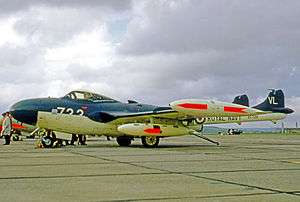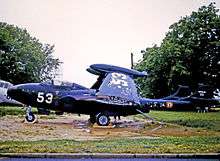de Havilland Sea Venom
| Sea Venom / Aquilon | |
|---|---|
 | |
| Operational Royal Navy Sea Venom FAW.22 at RAF Chivenor in 1969 | |
| Role | Fighter-bomber |
| National origin | United Kingdom |
| Manufacturer | de Havilland Aircraft Company SNCASE |
| First flight | 19 April 1951 |
| Primary users | Royal Navy French Navy Royal Australian Navy |
| Developed from | de Havilland Venom |
The de Havilland Sea Venom was a British postwar carrier-capable jet aircraft developed from the de Havilland Venom. It served with the Royal Navy Fleet Air Arm and with the Royal Australian Navy. The French Navy operated the Aquilon, a version of the Sea Venom FAW.20 licence-built by SNCASE (Sud-Est).
Design and development
The Sea Venom was the navalised version of the Venom NF.2 two-seat night fighter, and was used as an all-weather interceptor by the Fleet Air Arm (FAA). The necessary modifications for use on the Royal Navy's aircraft carriers included folding wings, a tailhook (which retracted into a characteristic "lip" over the jetpipe) and strengthened, long-stroke undercarriage. The canopy was modified to allow ejection from underwater. The first prototype made its first flight in 1951, and began carrier trials that same year. A further two prototypes were built.[1] The first production Sea Venom took the designation FAW.20 (Fighter, All-Weather). It was powered by a single de Havilland Ghost 103 turbojet engine and its armament was the same as the RAF version. The next variant was the FAW.21, which included the modifications introduced in the Venom NF.2A and NF.3. Some of these modifications included the Ghost 104 engine, a clear-view canopy and American radar. The final Royal Navy variant was the FAW.22 powered by the Ghost 105 engine. A total of 39 of this type were built in 1957–58. Some were later fitted out with the de Havilland Firestreak air-to-air missile.
Seven FAW.21s were modified in 1958 for Electronic countermeasures (ECM) purposes, with the cannon replaced by the ECM equipment. These became the ECM.21. 831 Naval Air Squadron, the sole squadron to be equipped with it, was shore-based at RAF Watton from 1963 and disbanded in 1966. Converted FAW.22s were similarly known as the ECM.22.
A modernised Sea Venom project, the DH.116 with swept wings and upgraded radar was considered, but cancelled as the Royal Navy believed that any replacement needed two engines. The de Havilland Sea Vixen ultimately replaced the Sea Venom.
Operational history
Royal Navy service
The Sea Venom saw much service during its time with the Royal Navy. In 1956, they, alongside RAF Venoms, took part in the Suez War which began on 31 October. They were part of Nos. 809, 892 and 893 Naval Air Squadrons based on the light fleet carrier HMS Albion and fleet carrier HMS Eagle. The Anglo-French invasion, codenamed Operation Musketeer, took place in response to the nationalisation of the Suez Canal by Egypt's leader, General Nasser. The air war began on the 31 October 1956 signalling the beginning of the Suez War. The Sea Venoms launched many sorties, bombing a variety of targets in Egypt in the process.
In 1958, during the Cyprus Emergency, Sea Venoms of 809 NAS, operating off Albion, flew a number of sorties against the EOKA Cypriot nationalist forces. The type also saw service during conflicts in the Middle East.
By 1959, the Sea Venom began to be replaced in Royal Navy service by the de Havilland Sea Vixen, an aircraft that also had the distinctive twin-boom tail. The Sea Venom would be withdrawn from frontline service soon afterwards. The type continued to fly with second line FAA units until the last were withdrawn in 1970.
Service with other nations
.jpg)
Thirty-nine Sea Venom FAW.53s saw service with the Royal Australian Navy (RAN), replacing the Hawker Sea Fury. The Sea Venom entered service in 1956 and, during its service with the RAN, operated off the aircraft carrier HMAS Melbourne. It was taken out of first-line service in 1967, replaced by the American McDonnell Douglas A-4G Skyhawk. The Aquilon saw service with the French Navy until being withdrawn in 1963.
Variants
Sea Venom
- Sea Venom NF.20
- Prototype Sea Venom, based on Venom NF.2.,[2][3] three-built.
- FAW.20
- Initial production aircraft, based on Venom NF.2A. 4,850 lbf (21.6 kN) Ghost 103 turbojet engine, AI Mk 10 (US SCR 720) radar.[4] 50 built.[2]
- FAW.21
- Improved version, equivalent to Venom NF.3. 4,950 lbf (22.1 kN) Ghost 104 engine, AI Mk 21 (US APS-57) radar, strengthened long-stroke undercarriage.[5][6] 167 built.
- ECM.21
- Six FAW.21s modified from 1957 for ECM purposes. No armament.[7]
- FAW.22
- More powerful (5,300 lbf (23.6 kN)) Ghost 105 engine, giving improved high-altitude performance.[8] 39 new built.[6]
- ECM.22
- Equivalent of ECM.21, based on FAW.22
- FAW.53
- Australian designation for the Sea Venom FAW.21. 39 built.[4]
SNCASE Aquilon

SNCASE (Sud-Est) licence-built 121 Sea Venom FAW.20 as the Aquilon for the French Navy.
- Aquilon 20 - 4 examples assembled from the parts provided by de Havilland plus 25 locally built.
- Aquilon 201 - Single prototype built in France.
- Aquilon 202 - Two-seat version with ejector seats, an American AN/APQ-65 radar and air-conditioning. 50 built.
- Aquilon 203 - Single-seat version with an American AN/APQ-94 radar and equipped with racks for air-to-air missiles. Prototype converted from Aquilon 202 plus 40 built.
- Aquilon 204 - Two-seat training version without guns. 6 Converted from Aquilon 20.
Operators
Sea Venom operators
- Royal Navy Fleet Air Arm
- 700 Naval Air Squadron
- 736 Naval Air Squadron
- 738 Naval Air Squadron
- 750 Naval Air Squadron
- 766 Naval Air Squadron
- 787 Naval Air Squadron
- 800 Naval Air Squadron
- 808 Naval Air Squadron
- 809 Naval Air Squadron
- 810 Naval Air Squadron
- 831 Naval Air Squadron
- 890 Naval Air Squadron
- 891 Naval Air Squadron
- 892 Naval Air Squadron
- 893 Naval Air Squadron
- 894 Naval Air Squadron
- Airwork Fleet Requirements Unit
Aquilon operators
- French Navy Aviation Navale
- 11F Naval Squadron
- 16F Naval squadron
Surviving aircraft
.jpg)
- Aquilon 203 No.53 preserved at Rochefort-en-Terre, France.
- Sea Venom FAW.21 - XG613 on display at Polish Aviation Museum, Cracow, Poland (previously exhibited in Duxford).
- Sea Venom FAW.22 - WW145 on display at National Museum of Flight, East Fortune, United Kingdom.
- Sea Venom FAW.22 - XG680 on display at North East Aircraft Museum, Sunderland, United Kingdom.
- Sea Venom FAW.22 - XG691 is being restored at the Malta Aviation Museum in Malta.
- Sea Venom FAW.22 - XG730 is being restored at the de Havilland Aircraft Heritage Centre, United Kingdom
- Sea Venom FAW.22 - XG737 is being restored at East Midlands Aeropark.
- In Australia, Sea Venom FAW.53 are on static display at the Fleet Air Arm Museum at air station HMAS Albatross, at the South Australian Aviation Museum in Port Adelaide, South Australia and at the Australian National Aviation Museum at Moorabbin Airport in Melbourne.
Specifications (Sea Venom FAW.22)

Data from De Havilland's Sea Vixen[9][10]
General characteristics
- Crew: 2
- Length: 36 ft 7 in (11.15 m)
- Wingspan: 42 ft 10 in (13.06 m)
- Height: 8 ft 6¼ in (2.60 m)
- Wing area: 279.8 ft² (25.9 m²)
- Max. takeoff weight: 15,800 lb (7,167 kg)
- Powerplant: 1 × de Havilland Ghost 105 turbojet, 5,300 lbf (23.6 kN)
Performance
- Maximum speed: 575 mph (500 knots, 927 km/h) at sea level
- Range: 705 mi (613 nmi, 1,135 km)
- Service ceiling: 39,500 ft (12,040 m)
- Rate of climb: 5,750 ft/min (29.2 m/s)
Armament
- Guns: 4× 20 mm (.79 in) Hispano Mk.V cannon, 150 rpg
- Rockets: 8× "60lb" RP-3 unguided rockets
- Bombs: 2× 1000 lb (450 kg) bombs[6]
See also
- Related development
- Aircraft of comparable role, configuration and era
- Grumman F9F Panther
- Hawker Sea Hawk
- McDonnell F2H Banshee
- Mikoyan-Gurevich MiG-9
- Republic F-84 Thunderjet
- Yakovlev Yak-25 (1947)
- Related lists
References
Notes
Bibliography
- Green, William. The World's Fighting Planes. London: Macdonald, 1964.
- Gunston, Bill. Fighters of the Fifties. Cambridge, UK: Patrick Stephens Limited, 1981. ISBN 0-85059-463-4.
- Mason, Francis K. The British Fighter since 1912. Annapolis, Maryland: Naval Institute Press, 1992. ISBN 1-55750-082-7.
- Jackson, A. J. (1978). de Havilland Aircraft since 1909. London: Putnam. ISBN 0-370-30022-X.
- Jackson, A. J. de Havilland Aircraft since 1909. London: Putnam, Third edition, 1987. ISBN 0-85177-802-X.
- Sturtivant, Ray. De Havilland's Sea Venom...a Naval Twin Boomer. Air International, Vol 39. No 2, August 1990, pp. 81–90. ISSN 0306-5634.
- Thetford, Owen. British Naval Aircraft 1912-58. London: Putnam Publishing, 1958.
- Wilson, Stewart. Sea Fury, Firefly and Sea Venom in Australian Service. Weston Creek, ACT, Australia: Aerospace Publications, 1993. ISBN 1-875671-05-6.
- Winchester, Jim, ed. "De Havilland Sea Vixen." Military Aircraft of the Cold War (The Aviation Factfile). Rochester, Kent, UK: The Grange plc., 2006. ISBN 1-84013-929-3.
External links
| Wikimedia Commons has media related to De Havilland Venom. |